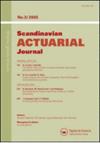系统因素引发的保险和金融风险具有任意依赖的连续时间风险模型中的破产
IF 1.4
3区 经济学
Q3 MATHEMATICS, INTERDISCIPLINARY APPLICATIONS
引用次数: 0
摘要
摘要本文研究了一类具有保险盈余过程和投资对数价格过程的连续时间风险模型的渐近分析,该模型由两个依赖的跳跃扩散过程驱动。我们考虑了由一系列系统因素引起的保险索赔与其相应的投资回报跳跃之间的任意依赖关系,这些因素的到达时间构成了续期计数过程。在正则变分的框架下,得到了初始财富变大时有限时间破产概率的一个简单统一的渐近公式。结果表明,在弱相关情况下,债权的尾部决定了有限时间破产概率的确切衰减率,而投资收益的跳跃只对渐近公式的系数有贡献;然而,在强依赖情况下,它们都对有限时间破产概率产生重要影响,而在弱依赖情况下,有限时间破产概率被低估。关键词:渐近有限时间破产概率系统因素保险理赔投资回报跳跃感谢匿名审稿人的提意见和对本文的认真阅读。披露声明作者未报告潜在的利益冲突。注1根据美国人寿保险委员会的数据,“人寿保险公司是美国企业债券融资的主要来源,持有超过22%的美国公司债券”,“人寿保险公司为商业抵押贷款市场提供长期资本,融资超过5150亿美元,几乎占美国商业抵押贷款的六分之一”。安联集团2021年年度报告指出,截至2021年12月31日,整体资产组合已达到8085亿欧元,主要是债务投资(与2020年底相比,6723亿欧元减少了101亿欧元,主要是由于市场波动),其中约91%投资于投资级债券和贷款。见第90页。参见国际货币基金组织(2016)的一份报告。保险业:趋势和系统性风险影响。3.可从https://www.imf.org/External/Pubs/FT/GFSR/2016/01/pdf/c3.pdf.3找到保险业巨头美国国际集团的崩溃和濒临破产,主要是由其5260亿美元的信用违约掉期投资组合造成的美国财产损失保险协会估计,每月因新冠肺炎疫情,员工人数在100人以下的企业的业务中断损失为2550亿美元至4310亿美元。安联集团的资产管理业务部门受到严重的金融市场混乱和相关投资者不确定性的影响,导致管理下资产的市场估值为负,并在2020年第一季度出现净流出。然而,在随后的几个季度中,该业务部门通过达到强劲的积极市场效应和第三方净流入而完全恢复。同时,截至2020年12月31日,财产-意外险业务部门受到了11亿英镑的负面影响。损失由意外的业务中断、娱乐和信贷造成。参见《安联集团2020年年报》122页。澳大利亚保险委员会(Insurance Council of Australia)估计,与气候有关的极端事件每年造成的保险损失总额为37亿美元,其中严重的森林大火占22亿美元。http://www.icadataglobe.com/access-catastrophe-data/(2020年6月访问)私人保险业管理着超过16万亿美元的资金,其全球资产也将面临未来气候风险。气候变化的实际影响将直接影响保险和再保险公司的投资部门。应该认识到,对保险公司投资组合的风险评估需要纳入对气候变化影响的分析。参见Herweijer et al. (Citation2009)和gizio et al. (Citation2019)。杨洋感谢国家社科基金(No. 22BTJ060)、教育部人文社会科学基金(No. 20YJA910006)、江苏省自然科学基金(No. 20YJA910006)的资助。BK20201396),江苏省高校自然科学基金项目(23KJA110002)。范亚辉感谢江苏省教育厅研究生科研与实践创新项目(项目编号:1139902)的资助。KYCX23_2268)。 锦泉园感谢中国香港特别行政区研究资助局(研究资助局编号:HKU17306220)。本文章由计算机程序翻译,如有差异,请以英文原文为准。
Ruin in a continuous-time risk model with arbitrarily dependent insurance and financial risks triggered by systematic factors
AbstractThis paper is devoted to asymptotic analysis for a continuous-time risk model with the insurance surplus process and the log-price process of the investment driven by two dependent jump-diffusion processes. We take into account arbitrary dependence between the insurance claims and their corresponding investment return jumps caused by a sequence of systematic factors, whose arrival times constitute a renewal counting process. Under the framework of regular variation, we obtain a simple and unified asymptotic formula for the finite-time ruin probability as the initial wealth becomes large. It turns out that, in the weakly dependent case, the tails of the claims determine the exact decay rate of the finite-time ruin probability while the investment return jumps only contribute to the coefficient of the asymptotic formula; however, in the strongly dependent case, they both produce essential impacts on the finite-time ruin probability which is under-estimated in the weakly dependent case.Keywords: Asymptoticsfinite-time ruin probabilitysystematic factorsinsurance claimsinvestment return jumpsMSC: 62P0562E1091B30 AcknowledgmentsThe authors would like to thank the anonymous referee for his/her suggestive comments and very careful reading of the paper.Disclosure statementNo potential conflict of interest was reported by the author(s).Notes1 According to the American Council of Life Insurers, ‘life insurers are a major source of bond financing for American business, holding more than 22% of all U.S. corporate bonds’ and ‘life insurers provide long-term capital to the commercial mortgage market, financing more than 515 billion dollars, or almost one-sixth, of U.S. commercial mortgages’. The Annual Report 2021 of Allianz Group stated that as of 31 December 2021, the overall asset portfolio has reached 808.5 billion euros mainly in the debt investments (672.3 billion decreased by 10.1 billion compared to year end 2020, mainly due to market movements), about 91% of which was invested in investment-grade bonds and loans. See page 90. Available at https://www.allianz.com/en/investorrelations/results-reports/annual-reports.2 See a report from the International Monetary Fund (2016). The insurance sector: trends and systemic risks implications. Available at https://www.imf.org/External/Pubs/FT/GFSR/2016/01/pdf/c3.pdf.3 The collapse and near-failure of the insurance giant American International Group was caused largely by its 526 billion dollars portfolio of credit default swaps.4 The American Property Casualty Insurance Association estimated that the monthly COVID-19 business interruption losses just for businesses with 100 or fewer employees was 255–431 billion dollars per month. Available at http://www.pciaa.net/pciwebsite/cms/content/viewpage?sitePageId=60052.5 The business segment Asset Management of the Allianz Group was impacted by the severe financial market disruption and related investor uncertainties which led to a negative market valuation of assets under management, and net outflows in the first quarter of 2020. However, in the subsequent quarters, the business segment fully recovered by reaching strong positive market effects and third-party net inflows. Meanwhile, the business segment Property-Casualty was negatively impacted with an amount of 1.1 billion pounds as of 31 December 2020. Losses resulted from unintended business interruption coverage, entertainment, and credit. See page 122 of The Annual Report 2020 of Allianz Group. Available at https://www.allianz.com/en/investor_relations/results-reports/annual-reports/annual-report-archive.html.6 The Insurance Council of Australia estimated the total annual insured losses due to climate-related extreme events was 3.70 billion dollars, of which the severe bushfires accounted for 2.2 billion. http://www.icadataglobe.com/access-catastrophe-data/ (accessed June 2020).7 With more than 16 trillion dollars in funds under management, the global assets of the private insurance industry will also have substantial exposure to future climate risk. The physical impacts of climate change will directly impact the investment arms of insurance and reinsurance companies. It should be recognized that risk assessments of an insurer's investment portfolio need to incorporate an analysis of the impact of climate change. See Herweijer et al. (Citation2009) and Giuzio et al. (Citation2019).Additional informationFundingYang Yang acknowledges the financial support by the National Social Science Fund of China (No. 22BTJ060), the Humanities and Social Sciences Foundation of the Ministry of Education of China (No. 20YJA910006), Natural Science Foundation of Jiangsu Province of China (No. BK20201396), and Natural Science Foundation of the Jiangsu Higher Education Institutions (No. 23KJA110002). Yahui Fan acknowledges the financial support by the Postgraduate Research & Practice Innovation Program of Jiangsu Provincial Department of Education (No. KYCX23_2268). Kam Chuen Yuen acknowledges the financial support by the Grant from the Research Grants Council of the Hong Kong Special Administrative Region, China (No. HKU17306220).
求助全文
通过发布文献求助,成功后即可免费获取论文全文。
去求助
来源期刊

Scandinavian Actuarial Journal
MATHEMATICS, INTERDISCIPLINARY APPLICATIONS-STATISTICS & PROBABILITY
CiteScore
3.30
自引率
11.10%
发文量
38
审稿时长
>12 weeks
期刊介绍:
Scandinavian Actuarial Journal is a journal for actuarial sciences that deals, in theory and application, with mathematical methods for insurance and related matters.
The bounds of actuarial mathematics are determined by the area of application rather than by uniformity of methods and techniques. Therefore, a paper of interest to Scandinavian Actuarial Journal may have its theoretical basis in probability theory, statistics, operations research, numerical analysis, computer science, demography, mathematical economics, or any other area of applied mathematics; the main criterion is that the paper should be of specific relevance to actuarial applications.
 求助内容:
求助内容: 应助结果提醒方式:
应助结果提醒方式:


